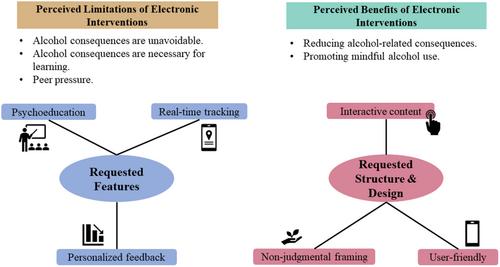Discovering what young adults want in electronic interventions aimed at reducing alcohol-related consequences
Abstract
Background
Despite intervention efforts, negative alcohol-related consequences continue to impact young adults. Most alcohol interventions focus on reducing alcohol consumption; however, previous research indicates that focusing solely on alcohol use may not decrease consequences. Additionally, many alcohol interventions have diminishing engagement, and few are designed with young adults involved in the development process. Drawing on user-centered design, this study sought to understand young adult perceptions, preferences, and needs for electronic interventions specifically aimed at reducing alcohol consequences.
Methods
Using semi-structured qualitative interviews, 21 young adult drinkers (ages 18–24; 57.1% female) shared their opinions regarding the need for electronic interventions (i.e., mobile or web-delivered) to reduce alcohol consequences as well as their preferences for content, features, and ways to increase engagement. Interviews were coded and analyzed using a multi-step thematic analysis approach.
Results
As part of our discovery phase of intervention development, content coding revealed four main themes. Participants perceived several benefits of interventions focused on alcohol consequences, such as promoting mindful alcohol use and reducing alcohol-related harms. Participants also discussed perceived limitations of such programs, including believing consequences from drinking are unavoidable, necessary for learning, and associated with peer pressure. Preferences for features included real-time tracking, personalized feedback, and psychoeducation along with preferences for design including non-judgmental framing, interactive content, and a user-friendly platform.
Conclusions
Engaging end users early in the development process is a valuable approach to increase intervention relevancy with the target population. This can also inform intervention content and design to maximize engagement and satisfaction (e.g., framing, features, and interactivity) while also reducing barriers identified early on (e.g., peer pressure).


 求助内容:
求助内容: 应助结果提醒方式:
应助结果提醒方式:


